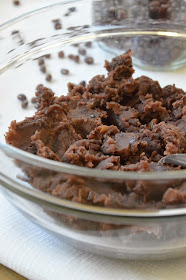This versatile sweet filling is frequently used in cakes, breads and desserts in various Asian cuisines. Some popular ways to eat them include: baked breads, steamed buns, dessert soups, pancakes, mooncakes, mochi, tangyuan or glutinous rice cakes, etc. You will inevitably find "red bean" in many Asian restaurants' dessert menus.
There are different ways to make red bean paste, some of the most common being:
1) Whole red beans - Red beans boiled with sugar
2) Mashed - Red beans boiled with sugar and mashed either lightly or vigorously, depending on desired texture. The consistency (how dry or wet) may be adjusted based on the intended purpose or preference.
3) Smooth - Red beans boiled without sugar, husk is removed by straining paste through sieve. Sugar and sometimes oil is added and cooked to create a smoother paste.
As red bean is very well-liked by my family, I often have to think of creative ways to cook it. I find it's always helpful to have prepared red bean paste on hand. While it is possible to buy the canned version from supermarkets, it is not difficult to make your own red bean paste. All you need is red beans, water and sugar, slowly cooked over low heat. You can also make a larger portion and freeze the rest which is not used immediately.
Today's recipe is based on the simple "Mashed" method above. I prefer to use rock sugar in this recipe as I think it has a certain depth of flavor which works very well here. However if you do not have rock sugar, regular sugar is fine too. As rock sugar is more condensed and sweeter than regular sugar, we use less of it for the same amount of red beans.
In the coming days, I will also share some of our favorite recipes using red bean.
RECIPE FOR RED BEAN PASTE
__________________________________________
Ingredients
1 cup red beans
3+3 cups water
160g rock sugar (or 200g /1 cup regular sugar)
1) Over high heat, pre-boil red beans in 3 cups of water for 5 minutes and discard water. This helps to remove bitterness.
2) Add 3 cups of water to red beans and bring to a boil over high heat. Turn to low heat, cover with lid, and simmer for 1.5 to 2 hours. Stir occasionally. Add rock sugar or sugar halfway (about 45 minutes) into cooking.
3) Check water consistency towards the end and add a little water if it becomes too dry. The consistency can be adjusted based on intended purpose and preference.
4) When the red beans are very soft and can be easily crushed, it is done.
- If it is too wet, turn up the heat for water to evaporate.
- If it is too dry, add a little more water.
The red bean paste will dry up a bit after it cools down, so remove from heat before it reaches the desired consistency. I use a fork to mix well and lightly mash it.
5) Transfer to a container and allow to cool down. If not using immediately, store in airtight container and refrigerate or freeze.




It looks the same as our red bean paste. I am just wondering if some Chinese red bean paste contains sesami oil as well.
ReplyDeleteI believe many people use regular vegetable oil with a more neutral taste. Sesame oil has quite a strong taste but perhaps some like it?
ReplyDelete